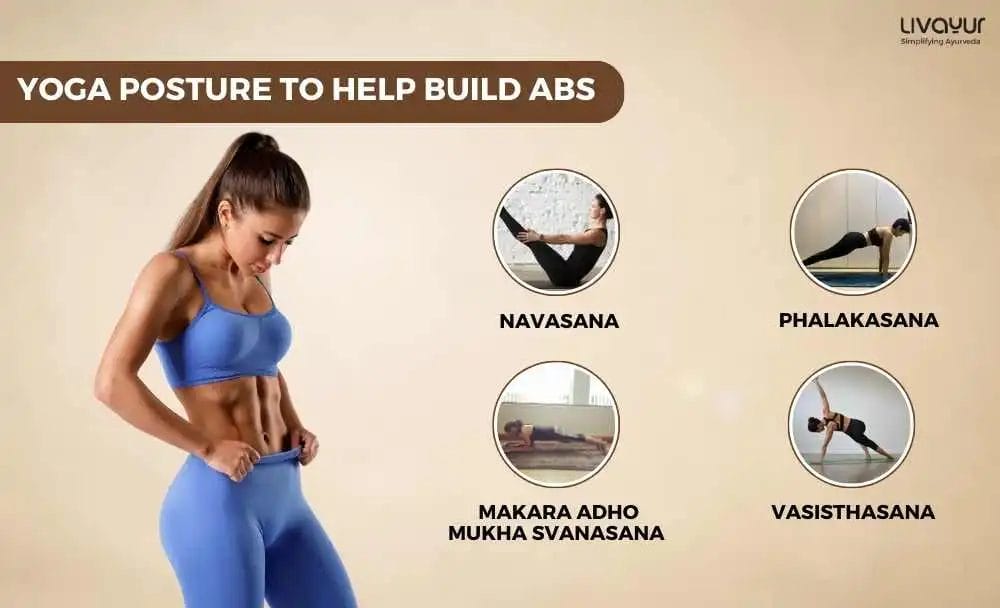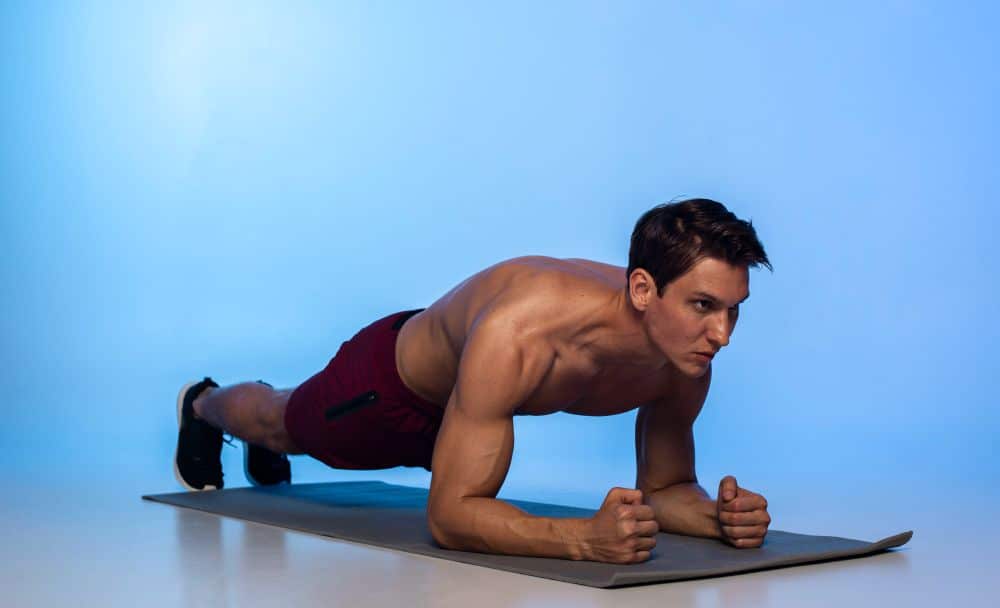
A b core enhances your athletic abilities and supports proper posture. Furthermore, it reduces the risk of injury in everyday activities. Are you an athlete aiming for peak performance? A fitness enthusiast striving for a toned midsection? Looking to improve your core strength?
This article will provide practical exercises targeting different areas of your core. There’s a versatility to suit your individual needs. So, let’s dive in and discover exercises to help you sculpt defined abs and build a solid foundation for your fitness journey.
Benefits of abs exercise
Engaging in regular abs exercises offers the following benefits that extend beyond just achieving a toned midsection:
- Core strength and stability
Your core muscles are crucial in maintaining proper posture and body stability. Strengthening these muscles will enhance your ability to perform movements with control and efficiency.
- Improved athletic performance
A b core is fundamental for athletes across all disciplines. A stable core enhances your power and endurance. It is a solid foundation for generating force and maintaining optimal body alignment during dynamic movements.
- Injury prevention
Weak core muscles contribute to bad posture and improper alignment. It increases the risk of injuries in everyday activities and sports. Abs exercises help fortify your core to reduce the spine strain and improve your body’s ability to withstand external forces.
- Enhanced functional fitness
Your core muscles are actively involved in daily functional movements like lifting and bending. Strengthening your abs improves your ability to perform these activities efficiently and with reduced strain on your body.
- Improved posture
A b core promotes better posture by supporting the alignment of your spine. Weak abdominal muscles can lead to slouching and rounded shoulders. Strengthening your abs helps with proper spinal alignment.

15 best abs exercise
Here are 15 of the best abs exercises you can consider to strengthen your core muscles:
- Plank
A classic abs exercise for the gym that targets the entire core, including the rectus abdominis and obliques. Start in a push-up position, resting on your forearms, and hold your body in a straight line for a specified duration.
- Bicycle crunches
Lie on your back, bend your knees, and bring them towards your chest. With your hands behind your head, alternate bringing your right elbow towards your left knee and vice versa.

- Russian twists
Bend your knees on the floor and lean back slightly. Then, lift your feet off the ground. Twist your torso from side to side, touching the floor with your hands on each side.
- Mountain climbers
Begin this lower abs exercise in a push-up position. Then, bring one knee near the chest and quickly switch legs in a running motion. Remember to engage the core throughout.
- Reverse crunches
Lie on your back with your knees bent and lift your legs, bringing your knees towards your chest. Contract the abs to raise hips off the ground and then lower them back down.
- Hanging leg raises
Hang from a pull-up bar and lift your legs. Keep them straight until they form a 90-degree angle with your torso. Lower them back down with control.
- Dead bug
Lie on the back with arms extended towards the ceiling and your legs bent at a 90-degree angle. Lower one arm behind your head while straightening the opposite leg, then return to the starting position and repeat on the other side. You can do this abs exercise at home.
- Swiss ball crunches
Sit on a Swiss ball with your feet flat on the floor for this abs exercise at home. Walk your feet forward as you lie back, supporting your lower back on the ball. Perform crunches by contracting your abs and lifting your torso towards your thighs.
- Side plank
Lie on your side, resting on one forearm and the side of your foot. Raise hips off the ground to create a straight line till your feet. Hold for a specified duration and then switch sides.
- Standing cable woodchoppers
Attach a cable handle to a pulley, stand with your feet shoulder-width apart, and hold the handle with both hands. Rotate your torso diagonally across your body while pulling the cable down and across your opposite hip.
- Flutter kicks
Lie on your back with your legs extended. Lift your legs slightly off the ground and alternate kicking up and down in a scissor-like motion, keeping your core engaged.
- Medicine ball Russian twists
Bend your knees on the floor and hold a medicine ball before your chest. Lean back slightly, lift your feet off the ground, and twist your torso from side to side while holding the medicine ball.
- Lying leg raises
Lie on your back with your legs extended. Lift your legs straight towards the ceiling, keeping them together, and slowly lower them back down without touching the ground.
- Ab rollouts
Start by kneeling on the floor and holding an ab wheel or a barbell with weights in front of you. Roll the wheel or barbell forward, extending your body, and then roll back to the starting position using your core muscles.
- Seated Russian twists
Sit on the floor with bent knees. Next, elevate feet off the ground and hold a weight or medicine ball with both hands and twist your torso from side to side, touching the weight to the ground on each side.
Ayurvedic approach to fitness
Ayurveda offers a unique approach to fitness that goes beyond physical exercise. According to Ayurveda, fitness encompasses not only a b and healthy body but also a balanced mind and harmonious spirit. In this approach, fitness is an integral part of overall well-being achieved through a combination of proper nutrition, mindful movement, and a balanced lifestyle.
Ayurveda recognizes each individual is unique. With their own specific body type or dosha (Vata, Pitta, or Kapha), the approach to fitness should be tailored accordingly. Different types of exercise, like yoga, are recommended based on one’s dosha to restore balance and optimize physical health.
Additionally, Ayurveda emphasizes the importance of regular daily routines (dinacharya) to support optimal fitness. These routines include waking up early, practicing self-care rituals, eating nourishing meals at regular times, and aligning daily activities with the natural rhythms of the body and the environment.
Yoga postures to build abs
Yoga can be a highly effective practice when building b and toned abs. Here are some yoga postures specifically designed to sculpt and strengthen your abs.
- Boat pose (Navasana)
Boat Pose is a classic yoga posture that primarily targets the abs. Sit with bent knees and lean back slightly. Lift your feet off the ground and balance on your sitting bones. Extend your legs forward, parallel to the floor, while keeping your spine straight and shoulders relaxed. For an added challenge, extend your arms parallel to your legs. Hold this pose for several breaths, gradually increasing the duration as you build strength.
- Plank Pose (Phalakasana)
Plank Pose is an excellent full-body exercise that engages the core, including the abs. Start in a push-up position with palms flat on the mat and your arms extended. Align your shoulders over your wrists and extend your legs behind you, keeping them hip-width apart. Engage the core, bring navel toward your spine, and hold the position for 30 seconds to a minute. Remember to maintain a straight line from your head to your heels.
- Side Plank (Vasisthasana)
Side Plank targets the obliques, which are the muscles on the sides of your waist. Begin in Plank Pose, then shift your weight onto your right hand and the outer edge of your right foot. Stack your left foot on top of your right foot and lift your left arm toward the ceiling. Keep your body straight, engage your core, and hold for 30 seconds to a minute. Repeat on the other side.
- Dolphin Plank (Makara Adho Mukha Svanasana)
Dolphin Plank is a modification of the traditional plank that further engages the abs and shoulders. Start by coming onto your forearms and knees, with your elbows directly under your shoulders. Extend your legs behind you, keeping your body parallel to the floor. Engage your core, bring your shoulder together, and hold for 30 seconds to a minute. Keep your neck relaxed and gaze down to maintain proper alignment.
FAQ
What is the most effective ab exercise?
The plank is usually one of the most effective ab exercises as it engages multiple core muscles, including the rectus abdominis.
What is the best 6-pack exercise?
There is no single “best” exercise for a six-pack. A combination of exercises targeting the entire core, like planks and crunches, can help sculpt and strengthen the abdominal muscles.
How to get a six-pack fast?
Achieving a six-pack requires a combination of regular exercise, a healthy diet, and body fat reduction. Incorporate practical ab exercises and maintain a calorie-controlled diet. Furthermore, perform regular cardiovascular exercises to shed excess body fat and reveal your abdominal muscles.
How to get a six-pack in 1 week?
Achieving a six-pack in just one week is unrealistic as it requires dedicated effort and time. Developing visible abdominal muscles involves a combination of regular exercise, proper nutrition, and reducing body fat. Focus on a long-term approach by incorporating a well-rounded fitness routine and maintaining a balanced diet for sustainable results.
Conclusion
Incorporating abs exercises into your fitness routine will strengthen your core muscles and improve athletic performance. Remember to perform each exercise thoroughly and gradually increase intensity as your strength improves.
Building a solid core takes time and consistency, so be patient and stay committed to your fitness goals. Prioritizing abs exercises and combining them with a balanced diet will help achieve a b and defined core.
Disclaimer
The information provided here is not intended to replace professional advice or treatment.
















